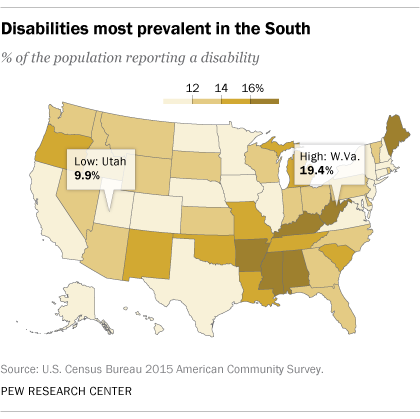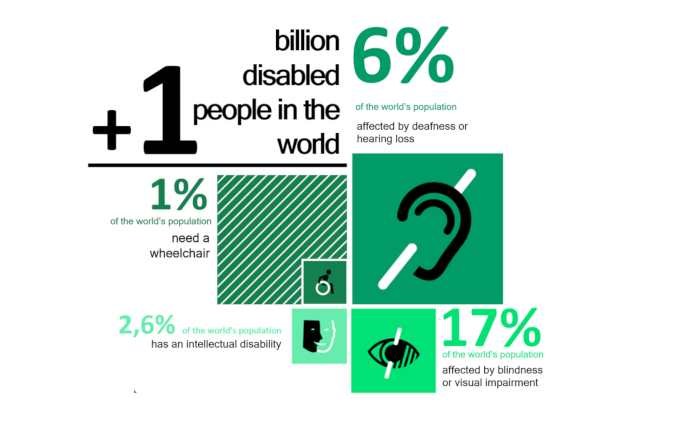2010 presents estimates of disability status and type and is the first such report with analysis since the Census Bureau published statistics in a similar report about the 2005 population of people with disabilities. According to the Census Bureau there are more than 56 million Americans living with a disability.
 7 Facts About Americans With Disabilities Pew Research Center
7 Facts About Americans With Disabilities Pew Research Center
And recent projections suggest that 354 million disabled Americans will be eligible to vote in.

How many americans are disabled. In the past three decades the number of Americans who are on disability has skyrocketed. According to the US Centers for Disease Control and Prevention CDC 1 in 4 adults in the US has a disability including impairments with vision hearing mobility and cognition. 61 million adults in the United States live with a disability 26 percent one in 4 of adults in the United States have some type of disability.
Adults 61 million Americans have a disability that impacts major life activities according to a report in CDCs Morbidity and Mortality Weekly Report. The rise has come even as medical advances have allowed many more people to remain on the job and new laws. For the purposes of federal disability nondiscrimination laws such as the Americans with Disabilities Act ADA Section 503 of the Rehabilitation Act of 1973 and Section 188 of the Workforce Innovation and Opportunity Act the definition of a person with a disability is typically defined as someone who 1 has a physical or mental impairment.
The most common disability type mobility affects 1 in 7 adults. Persons with a disability were less likely to work in management professional and related occupations than those without a disability 361 percent compared with 433 percent. Graphic of the United States.
2014 Americans with Disabilities. Despite the increase the 9 million or so people getting Social Security disability benefits represent just a small subset of Americans living with disabilities. Census 2000 counted 497 million people with some type of long-lasting condition or disability.
According to the report the total number of people with a disability increased by 22. In addition nearly 11 million of those with disabilities that were age 6 years and older needed help with everyday activities such as taking a shower or bath and getting around inside the home. This proportion only grows with age with 40 percent of those over age 65 living with a disability.
Political engagement is important to many people with disabilities. While not all people reporting disabilities were found to be severely disabled nearly 35 million were indeed classified as severely disabled. There were nearly 40 million Americans with a disability in 2015 representing 126 of the civilian non-institutionalized population according to the US.
These applications are those received at Social Security field offices teleservice centers and claims filed electronically on the internet. ODEP promotes the availability and use of disability data and statistics to further education research and policy initiatives to improve employment opportunities and outcomes for people with disabilities. The report Americans with Disabilities.
At least 51 million working adults in the United States are without disability insurance other than the basic coverage available through Social Security 1. There are 36 million people who have at least one disability about 12 percent of the total US. A The number of applications is for disabled-worker benefits only and as such excludes disabled childs and disabled widowers benefits.
One in 4 US. They represented 193 percent of the 2572 million people who were aged 5 and older in the civilian non-institutionalized population -- or nearly one person in five This percentage varies depending on how disabilities are defined. See table 3 The proportion of persons employed in government was slightly higher for persons with a disability than for persons without a disability in 2020 146.
Those with vision difficulties number 65 million while. Yet the share of Americans with disabilities varies widely across demographic groups and geography. Only 48 percent of American adults indicate they have enough savings to cover three months of living expenses in the event theyre not earning any income 2.
2014 provides estimates of disability prevalence in the United States. The percentage of people living with disabilities is highest in the South. Disabilities include visible conditions such as spinal cord injuries visual impairments or hearing loss and invisible disabilities such as learning disabilities mental health or Autism.
Social Security works aggressively to prevent detect and prosecute fraud. More than 56 million Americans or 19 of the population are living with some form of disability whether physical mental or communicative according to the Census Bureau. Disabled Americans were more likely to follow 2016 Presidential campaign closely than those without a disability according to Pew.
Credible consistent data is critical to creating change.
